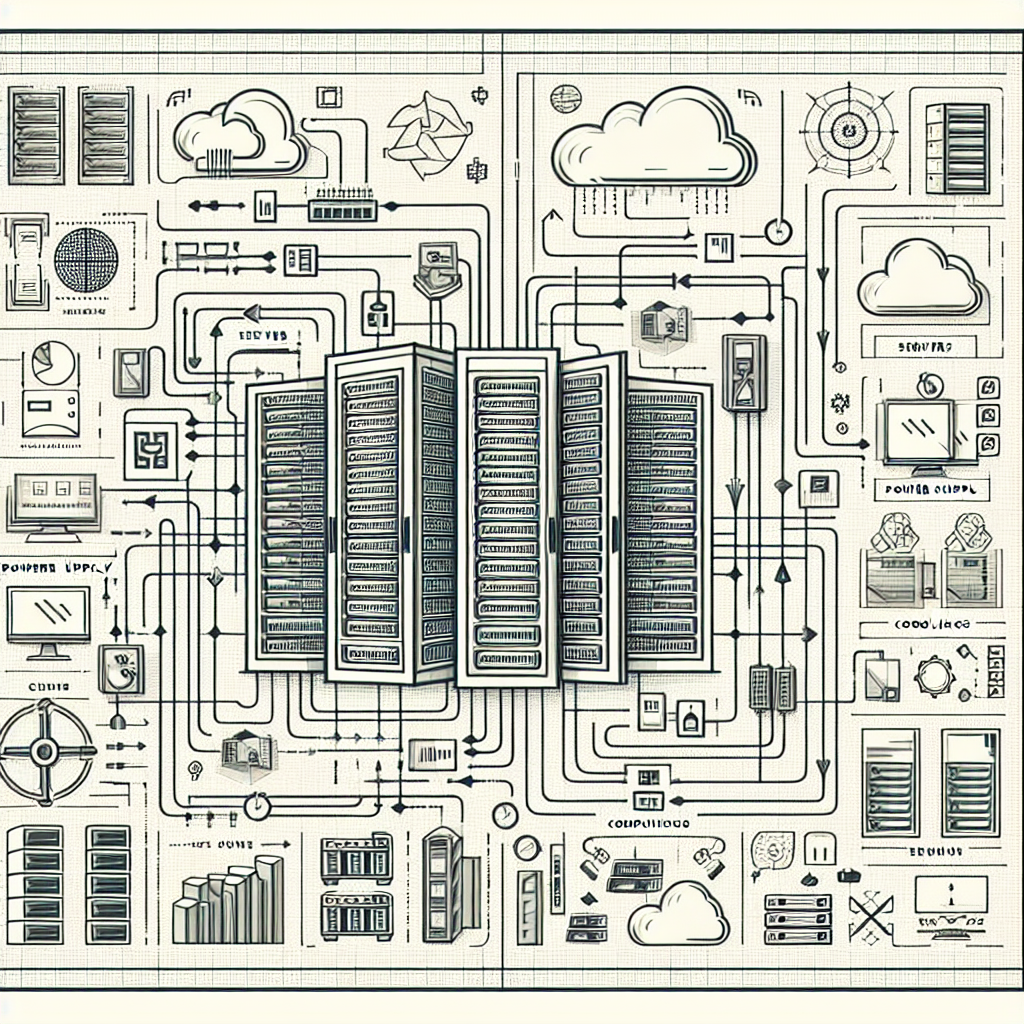Your cart is currently empty!
Tag: Successful

The Essential Guide to Implementing a Successful Data Center Reactive Maintenance Strategy
In today’s digital age, data centers are the backbone of any organization’s operations. They house critical IT infrastructure and store vast amounts of data, making them essential for business continuity. However, data centers are also prone to equipment failures and downtime, which can have a significant impact on business operations and revenue.To mitigate the risk of downtime, many organizations implement a proactive maintenance strategy to ensure their data center equipment is running efficiently. However, proactive maintenance alone may not be enough to prevent unexpected failures. This is where reactive maintenance comes into play.
Reactive maintenance, also known as corrective maintenance, involves responding to equipment failures as they occur. While this approach may seem less ideal than proactive maintenance, it is still an essential component of a comprehensive maintenance strategy. In fact, a successful data center maintenance strategy should incorporate both proactive and reactive maintenance to ensure optimal performance and uptime.
Here are some essential tips for implementing a successful data center reactive maintenance strategy:
1. Establish a clear process for reporting and tracking equipment failures: It is crucial to have a system in place for employees to report equipment failures promptly. This will help the maintenance team prioritize and address issues in a timely manner.
2. Develop a comprehensive maintenance schedule: While proactive maintenance helps prevent equipment failures, it is still essential to have a schedule for reactive maintenance tasks. Regularly inspecting and servicing equipment can help identify potential issues before they escalate into major failures.
3. Invest in monitoring tools: Monitoring tools can help track the performance of data center equipment in real-time, allowing maintenance teams to identify potential issues before they cause downtime.
4. Train your maintenance team: Proper training is essential for a successful reactive maintenance strategy. Ensure your maintenance team is well-equipped to handle equipment failures efficiently and effectively.
5. Prioritize critical equipment: Not all equipment failures are created equal. Identify critical equipment that can cause significant downtime if it fails and prioritize maintenance tasks accordingly.
6. Document all maintenance tasks: Keeping detailed records of all maintenance tasks can help identify trends and patterns in equipment failures, enabling proactive measures to prevent future issues.
In conclusion, implementing a successful data center reactive maintenance strategy is essential for ensuring optimal performance and uptime. By incorporating proactive and reactive maintenance approaches, organizations can minimize downtime and maximize the efficiency of their data center operations. By following these essential tips, organizations can effectively manage equipment failures and maintain a reliable data center infrastructure.

How to Implement a Successful Data Center Preventative Maintenance Program
A data center is a critical component of any organization’s operations, housing the servers, storage, and networking equipment that keep the business running smoothly. To ensure that your data center operates efficiently and reliably, implementing a successful preventative maintenance program is essential.Preventative maintenance involves regularly scheduled inspections, tests, and repairs to ensure that equipment is functioning properly and to identify and address potential issues before they cause downtime or data loss. By implementing a preventative maintenance program, you can extend the life of your equipment, reduce the risk of unexpected failures, and minimize costly downtime.
Here are some key steps to implementing a successful data center preventative maintenance program:
1. Develop a comprehensive maintenance plan: Start by creating a detailed maintenance plan that outlines all the equipment in your data center, the maintenance tasks that need to be performed, and the frequency at which they should be completed. Include a schedule for routine inspections, cleaning, and testing of critical components such as servers, cooling systems, and power distribution units.
2. Assign responsibilities: Clearly define roles and responsibilities for implementing the maintenance program. Designate specific team members or outside vendors to perform maintenance tasks, and ensure that everyone understands their responsibilities and the importance of adhering to the maintenance schedule.
3. Establish a tracking system: Implement a system for tracking maintenance tasks, including when they were completed, who performed them, and any issues that were identified. This will help you monitor the effectiveness of your maintenance program and identify any trends or recurring problems that need to be addressed.
4. Regularly monitor and test equipment: In addition to routine maintenance tasks, regularly monitor and test equipment to ensure that it is functioning properly. Use monitoring tools to track performance metrics such as temperature, humidity, and power usage, and conduct regular tests to identify any potential issues before they escalate.
5. Document and review maintenance procedures: Document all maintenance procedures and ensure that they are easily accessible to all team members. Regularly review and update procedures to incorporate any changes in equipment or best practices, and provide training to ensure that everyone is familiar with the maintenance tasks that need to be performed.
6. Implement a disaster recovery plan: While preventative maintenance can help minimize the risk of equipment failure, it’s important to have a disaster recovery plan in place in case of a major outage or data loss. Ensure that you have backups of critical data and systems, and regularly test your disaster recovery plan to ensure that it is effective.
By following these steps and implementing a successful data center preventative maintenance program, you can ensure that your data center operates efficiently and reliably, minimizing the risk of downtime and data loss. Investing time and resources in preventative maintenance now can save you money and headaches in the long run, ensuring that your data center continues to support your organization’s operations effectively.

Key Components of a Successful Data Center Incident Management Program
Data centers are the backbone of modern businesses, housing critical IT infrastructure and storing vast amounts of data. With the increasing complexity and importance of data centers, it is essential for organizations to have a robust incident management program in place to quickly respond to and resolve any issues that may arise.A successful data center incident management program is built on key components that ensure effective and efficient handling of incidents. These components include:
1. Clearly defined roles and responsibilities: A well-defined incident management team with clearly assigned roles and responsibilities is crucial for ensuring a coordinated and effective response to incidents. This team should include individuals with the necessary technical expertise to troubleshoot and resolve issues quickly.
2. Incident response plan: An incident response plan outlines the steps that need to be taken in the event of an incident, including how to detect, report, assess, and respond to incidents. This plan should be regularly updated and tested to ensure it remains effective in addressing new and evolving threats.
3. Monitoring and alerting systems: Monitoring and alerting systems are essential for detecting incidents in real-time and notifying the incident management team. These systems should be configured to alert the team to any abnormal behavior or potential security breaches.
4. Incident categorization and prioritization: Incidents should be categorized based on their severity and impact on the data center operations. This allows the incident management team to prioritize their response and allocate resources accordingly.
5. Communication protocols: Effective communication is key to a successful incident management program. Clear communication channels should be established to ensure that all team members are informed of the incident and its status. Regular updates should be provided to stakeholders to keep them informed of the situation.
6. Incident documentation and analysis: Documenting incidents and their resolution is important for identifying trends and patterns that can help prevent future incidents. An incident post-mortem should be conducted to analyze the root cause of the incident and identify areas for improvement.
7. Continuous improvement: A successful incident management program is never static and should be continuously reviewed and improved. Regularly conducting incident simulations and tabletop exercises can help identify weaknesses in the program and improve the team’s response capabilities.
In conclusion, a successful data center incident management program is essential for ensuring the stability and security of a data center. By implementing the key components outlined above, organizations can effectively respond to incidents and minimize the impact on their operations. Investing in a robust incident management program is an investment in the resilience and reliability of the data center infrastructure.

Case Studies in Successful Data Center Change Management
Change management is a crucial process in any organization, ensuring that transitions are seamless and that any potential disruptions are minimized. This is especially true in data centers, where any downtime or errors can have significant impacts on business operations. In order to better understand the importance of change management in data centers, it is useful to examine some case studies of successful implementations.One notable case study is that of a large financial services company that was undergoing a major technology upgrade in their data center. The company recognized the importance of change management in ensuring a smooth transition, so they implemented a comprehensive plan that included thorough testing, stakeholder communication, and contingency planning. As a result, the upgrade was completed on time and within budget, with minimal disruptions to day-to-day operations.
Another case study involves a healthcare organization that was looking to migrate their data center to a new location. This was a complex process that required careful planning and coordination to ensure that patient data remained secure and accessible throughout the transition. By implementing a detailed change management plan that included regular communication with staff, thorough testing, and backup procedures, the organization was able to successfully migrate their data center without any disruptions to patient care.
In both of these case studies, the key to success was a strong focus on change management. By carefully planning and executing the transition process, these organizations were able to avoid potential pitfalls and ensure that their data centers remained operational throughout the changes. This highlights the importance of having a structured approach to change management in data centers, as it can help organizations mitigate risks and ensure a successful transition.
Overall, these case studies demonstrate the importance of change management in data center operations. By implementing a comprehensive plan that includes thorough testing, stakeholder communication, and contingency planning, organizations can ensure that transitions are smooth and that disruptions are minimized. This not only helps to protect critical business operations, but also ensures that data remains secure and accessible throughout the process. As such, it is essential for organizations to prioritize change management in their data center operations in order to achieve successful outcomes.

Key Considerations for Successful Data Center Lifecycle Management
In today’s digital age, data centers play a crucial role in the operation of businesses and organizations. These facilities house and manage the critical IT infrastructure that supports daily operations and ensures the smooth functioning of various applications and services. Given the importance of data centers, it is essential for organizations to have a well-defined data center lifecycle management strategy in place to ensure optimal performance, efficiency, and reliability.Data center lifecycle management refers to the process of planning, designing, building, operating, and decommissioning data center facilities. It involves managing the entire lifecycle of a data center, from inception to retirement, to ensure that it meets the organization’s current and future IT needs. To successfully manage the lifecycle of a data center, there are several key considerations that organizations need to take into account:
1. Define clear objectives and goals: Before embarking on any data center project, it is essential to define clear objectives and goals for the facility. These objectives should align with the organization’s overall business strategy and IT requirements. By clearly defining the purpose and goals of the data center, organizations can ensure that the facility is designed and built to meet their specific needs.
2. Conduct a thorough assessment of current infrastructure: Before designing and building a new data center or making significant changes to an existing facility, organizations should conduct a comprehensive assessment of their current IT infrastructure. This assessment should include an inventory of existing hardware, software, and applications, as well as an analysis of performance metrics, capacity requirements, and future growth projections.
3. Develop a comprehensive data center design: The design phase is a critical component of data center lifecycle management. Organizations should work with experienced architects, engineers, and IT professionals to develop a comprehensive data center design that meets their specific requirements. The design should take into account factors such as power and cooling requirements, security measures, redundancy and resilience, scalability, and compliance with industry standards and regulations.
4. Implement efficient data center operations: Once the data center is built and operational, organizations need to implement efficient data center operations practices to ensure optimal performance and reliability. This includes monitoring and managing power and cooling systems, optimizing server and storage utilization, implementing security measures, and conducting regular maintenance and upgrades.
5. Plan for data center decommissioning: As data center technologies evolve and organizations’ IT requirements change, there may come a time when a data center needs to be decommissioned. Organizations should have a plan in place for decommissioning data center facilities, including proper disposal of equipment, data migration, and ensuring compliance with environmental regulations.
6. Continuously monitor and evaluate performance: Data center lifecycle management is an ongoing process that requires continuous monitoring and evaluation of the facility’s performance. Organizations should regularly review key performance metrics, such as uptime, energy efficiency, and capacity utilization, and make adjustments as needed to ensure optimal performance and efficiency.
By taking these key considerations into account, organizations can successfully manage the lifecycle of their data center facilities and ensure that they meet their current and future IT requirements. Effective data center lifecycle management can help organizations improve operational efficiency, reduce costs, and enhance the overall reliability and performance of their IT infrastructure.

Key Considerations for Conducting Successful Data Center Audits
Data centers are the backbone of modern businesses, housing critical IT infrastructure and sensitive data. As such, conducting regular audits of data centers is essential to ensure they are operating efficiently, securely, and in compliance with industry regulations. However, conducting a successful data center audit requires careful planning and consideration of key factors. In this article, we will discuss some important considerations to keep in mind when conducting data center audits.1. Define audit objectives: Before beginning the audit process, it is important to clearly define the objectives of the audit. This may include assessing the security controls in place, evaluating the efficiency of the data center operations, or ensuring compliance with industry standards. By establishing clear audit objectives, you can focus your efforts and resources on areas that are most critical to the business.
2. Identify key stakeholders: Data center audits involve multiple stakeholders, including IT teams, security personnel, compliance officers, and senior management. It is important to involve these stakeholders early in the audit process to ensure their buy-in and cooperation. Each stakeholder will have valuable insights and perspectives that can help guide the audit and ensure its success.
3. Develop a comprehensive audit plan: A well-defined audit plan is essential for conducting a successful data center audit. The plan should outline the scope of the audit, the methodologies and tools to be used, the timeline for completion, and the roles and responsibilities of each team member. By developing a detailed audit plan, you can ensure that the audit is conducted efficiently and effectively.
4. Conduct a thorough assessment: During the audit, it is important to conduct a thorough assessment of all aspects of the data center, including physical security, network infrastructure, data storage, and disaster recovery capabilities. This may involve conducting interviews with data center staff, reviewing documentation and logs, and performing technical assessments using specialized tools. By taking a comprehensive approach to the audit, you can identify any weaknesses or vulnerabilities that need to be addressed.
5. Document findings and recommendations: Once the audit is complete, it is important to document the findings and recommendations in a clear and concise report. The report should include a summary of the audit objectives, the methodology used, the findings of the audit, and recommendations for improvement. By documenting the audit findings, you can provide a roadmap for addressing any issues and improving the overall security and efficiency of the data center.
In conclusion, conducting successful data center audits requires careful planning, collaboration with key stakeholders, and a thorough assessment of all aspects of the data center. By following these key considerations, businesses can ensure that their data centers are operating securely, efficiently, and in compliance with industry regulations.

Case Studies: Successful Implementations of Energy-Efficient Data Centers
Data centers are a critical component of the modern digital economy, serving as the backbone of the internet and enabling businesses to store, process, and access vast amounts of data. However, data centers are also notorious for their high energy consumption, with some estimates suggesting that they account for 2% of global electricity usage.In recent years, there has been a growing awareness of the need to make data centers more energy-efficient in order to reduce their environmental impact and lower operating costs. Many companies have been implementing innovative solutions to achieve this goal, with some impressive results.
One notable example of a successful implementation of an energy-efficient data center is Google’s data center in Hamina, Finland. This facility is powered entirely by renewable energy sources, including wind and hydroelectric power. In addition, Google has implemented a number of energy-saving technologies, such as advanced cooling systems and server virtualization, to further reduce energy consumption. As a result, the Hamina data center has achieved an impressive power usage effectiveness (PUE) rating of 1.13, well below the industry average of 1.8.
Another example of a successful energy-efficient data center implementation is Microsoft’s data center in Quincy, Washington. This facility uses a combination of on-site solar and wind power generation, as well as energy-efficient server design and cooling systems, to significantly reduce its energy consumption. Microsoft has also implemented a smart energy management system that optimizes the use of resources based on real-time data, further improving efficiency. As a result, the Quincy data center has achieved a PUE rating of 1.15, making it one of the most energy-efficient data centers in the world.
These successful implementations of energy-efficient data centers demonstrate that it is possible to significantly reduce the environmental impact of data centers while also lowering operating costs. By investing in renewable energy sources, implementing energy-saving technologies, and optimizing resource usage, companies can not only reduce their carbon footprint but also improve their bottom line. As the demand for data continues to grow, it is crucial that more companies follow the example set by Google and Microsoft in order to build a more sustainable digital infrastructure for the future.

Key Steps for Conducting a Successful Data Center Inspection
Data centers play a crucial role in today’s digital world, serving as the backbone for storing, processing, and managing vast amounts of data. As such, it is essential to ensure that data centers are operating efficiently and effectively to support the growing demands of businesses and consumers. One way to ensure the smooth functioning of a data center is through regular inspections.Conducting a data center inspection is a critical task that should be carried out on a routine basis to identify and address any potential issues before they escalate into larger problems. Below are key steps for conducting a successful data center inspection:
1. Develop a checklist: Before conducting the inspection, it is important to create a comprehensive checklist that outlines the areas and components that need to be examined. This checklist should include items such as power distribution units, cooling systems, server racks, networking equipment, security measures, and fire suppression systems.
2. Schedule the inspection: Determine a suitable time to conduct the inspection when the data center is least active to minimize disruptions. Consider scheduling inspections during weekends or off-peak hours to ensure that all areas can be thoroughly examined without impacting operations.
3. Conduct visual inspections: Begin the inspection by conducting visual assessments of the data center environment. Look for signs of damage, wear and tear, overheating, leaks, or any other anomalies that may indicate potential issues. Check for proper cable management, cleanliness, and organization within the data center.
4. Test equipment and systems: Test critical equipment and systems such as UPS units, generators, HVAC systems, and fire suppression systems to ensure they are functioning properly. Monitor temperature and humidity levels to ensure they are within acceptable ranges to prevent equipment failures.
5. Inspect security measures: Verify that all security measures, such as access controls, surveillance cameras, and alarms, are in place and functioning effectively to prevent unauthorized access to the data center. Review logs and access records to identify any irregularities or suspicious activities.
6. Document findings: Document all findings and observations during the inspection, including any issues identified, recommendations for improvements, and actions taken to address them. Keep detailed records of inspections to track trends over time and ensure that all maintenance and repairs are completed in a timely manner.
7. Follow up on corrective actions: After the inspection, follow up on any corrective actions that were identified to address the issues found. Monitor progress and ensure that all necessary repairs and maintenance tasks are completed to maintain the optimal performance and reliability of the data center.
By following these key steps for conducting a successful data center inspection, organizations can proactively identify and mitigate potential risks, ensure the efficient operation of their data centers, and safeguard the integrity and security of their data. Regular inspections are essential for maintaining the performance and reliability of data centers and should be prioritized as part of a comprehensive data center management strategy.

Key Steps for Implementing a Successful Data Center Preventative Maintenance Program
Data centers are the backbone of any organization, housing critical IT infrastructure that supports business operations. With the increasing reliance on technology, it is crucial for data centers to operate at peak efficiency and reliability. One way to ensure this is through a comprehensive preventative maintenance program.Implementing a successful data center preventative maintenance program requires careful planning and execution. Here are some key steps to consider when developing and implementing a preventative maintenance program for your data center:
1. Assess Current Infrastructure: The first step in implementing a preventative maintenance program is to assess the current state of your data center infrastructure. This includes conducting a thorough audit of all equipment, systems, and processes to identify potential areas of weakness or vulnerability.
2. Develop a Maintenance Schedule: Once you have identified the key areas that require maintenance, the next step is to develop a maintenance schedule. This should outline the frequency of maintenance tasks, as well as the specific tasks that need to be performed on each piece of equipment or system.
3. Assign Responsibilities: It is important to clearly define roles and responsibilities for each member of your data center team. This includes assigning specific tasks to individuals or teams, as well as establishing protocols for reporting and tracking maintenance activities.
4. Implement Monitoring and Reporting Tools: To ensure that your preventative maintenance program is effective, it is important to implement monitoring and reporting tools that can track the performance of your data center infrastructure in real-time. This will allow you to identify potential issues before they escalate into major problems.
5. Train Your Team: In order for your preventative maintenance program to be successful, it is crucial that your team is properly trained on how to perform maintenance tasks and use monitoring tools effectively. Investing in training and development for your team will pay off in the long run by reducing downtime and increasing efficiency.
6. Regularly Review and Update the Program: Preventative maintenance programs should be dynamic and adaptable to changing circumstances. It is important to regularly review and update your program to ensure that it remains relevant and effective in maintaining the reliability and efficiency of your data center.
By following these key steps, you can develop and implement a successful preventative maintenance program for your data center that will help to reduce downtime, increase efficiency, and prolong the life of your critical IT infrastructure. Remember, prevention is always better than cure when it comes to maintaining the health and performance of your data center.

Key Components of a Successful Data Center Business Continuity Plan
In today’s technology-driven world, data centers play a crucial role in the operation of businesses of all sizes. These facilities house critical IT infrastructure and data that are essential for the day-to-day operations of organizations. However, with the increasing complexity and volume of data being generated and stored, the risk of data center disruptions and downtime is also on the rise. This is where a robust business continuity plan comes into play.A data center business continuity plan is a comprehensive strategy that outlines the procedures and protocols to ensure the uninterrupted operation of a data center in the event of a disaster or other disruptive event. This plan is essential for minimizing downtime, protecting critical data, and ensuring the continuity of business operations.
Key Components of a Successful Data Center Business Continuity Plan:
1. Risk Assessment and Analysis: The first step in developing a business continuity plan for a data center is to conduct a thorough risk assessment and analysis. This involves identifying potential risks and vulnerabilities that could impact the data center’s operations, such as natural disasters, power outages, cyber-attacks, or equipment failures.
2. Business Impact Analysis: Once the risks have been identified, it is important to assess the potential impact of these disruptions on the data center and the organization as a whole. This includes evaluating the financial, operational, and reputational consequences of downtime and data loss.
3. Recovery Objectives and Strategies: Based on the risk assessment and business impact analysis, the next step is to establish recovery objectives and develop strategies to mitigate the impact of disruptions. This includes defining recovery time objectives (RTO) and recovery point objectives (RPO) for critical systems and data.
4. Backup and Recovery Procedures: One of the key components of a data center business continuity plan is the implementation of robust backup and recovery procedures. This includes regularly backing up data, testing backup systems, and ensuring that data can be quickly restored in the event of a disaster.
5. Communication Plan: Effective communication is essential during a data center disruption to ensure that all stakeholders are informed and updated on the situation. A communication plan should outline the roles and responsibilities of key personnel, as well as the methods and channels of communication to be used during a crisis.
6. Training and Testing: A successful business continuity plan also includes regular training and testing of procedures to ensure that staff are familiar with their roles and responsibilities and that systems are functioning as intended. This helps to identify and address any gaps or weaknesses in the plan before an actual disaster occurs.
7. Continuous Improvement: Finally, a data center business continuity plan should be a living document that is regularly reviewed and updated to reflect changes in technology, operations, and risks. Continuous improvement is essential to ensure that the plan remains effective and relevant in the face of evolving threats.
In conclusion, a successful data center business continuity plan is essential for ensuring the resilience and continuity of operations in the face of disruptions. By incorporating key components such as risk assessment, recovery objectives, backup procedures, communication plans, and training, organizations can minimize downtime, protect critical data, and maintain business continuity in the event of a disaster.
